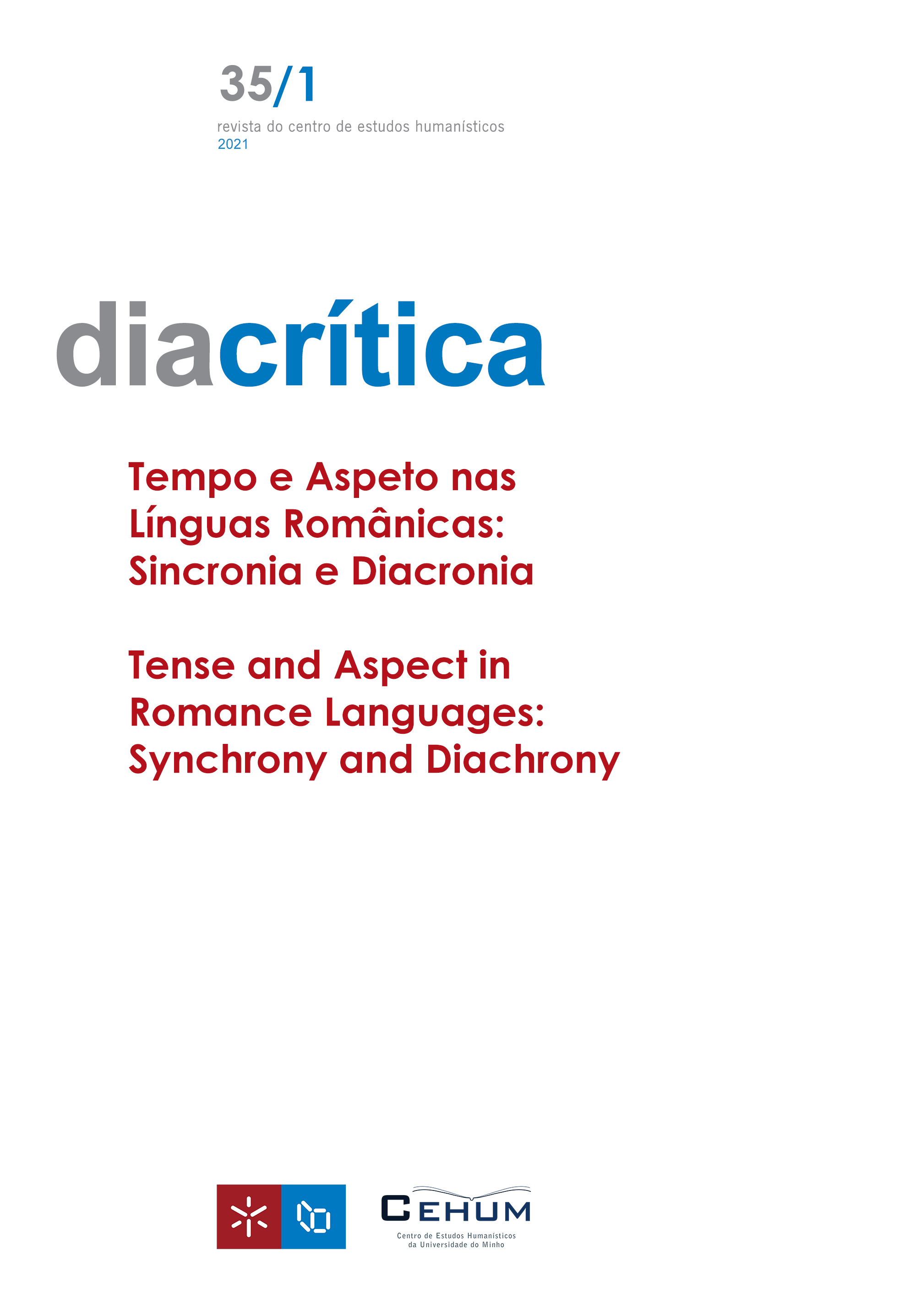The connection between adverb and aspect A cognitivist and multimodal proposal
DOI:
https://doi.org/10.21814/diacritica.5119Keywords:
Adverb, Aspect, Cognitive Grammar, Utterance Construction Grammar, Gesture StudiesAbstract
In Brazilian Portuguese, the expression of aspect is not restricted to verbs, but can be extended to adverbs. In this study, we aim to articulate, in the framework of Cognitive Grammar, the categories of adverb, iteration and aspect/aspectuality, to describe the category aspectualizer adverb of repetition. Also, we demonstrate how the category in question can be instantiated by the partially filled construction schema [QNT + times (‘vezes’)]. Considering the relevance of Gesture Studies in the instantiation of the category under analysis, the articulation between aspect and gesture in Cognitive Grammar is presented, as well as the model of Utterance Construction Grammar. Afterwards, the methodological procedures of gesture analyses and identification are presented, in correlation with speech, as well as the collection and analyses of illustrative examples. The discussion of results demonstrates that verbal constructions instantiated by the schema [QNT + times (‘vezes’)] can be linked to gesture repetition, marking iteration or reduplication, and to the gesture Image Schema CYCLE. Therefore, from the multimodal point of view, the succession of events or iterative acts, conveyed in speech, constitutes a limited or unlimited action, demonstrated in gestures.
References
Bressem, J. (2014). Repetitions in Gesture. In C. Müller, A. Cienki, E. Fricke, S. Ladewig, D. McNeill, & J. Bressem, (Eds.), Body – Language – Communication: An international handbook on multimodality in human interaction [Handbücher zur Sprach- und Kommunikationswissenschaft, Vol. 38, No. 2] (pp. 1641–1649). Berlin: De Gruyter Mouton.
Cienki, A. (1997). Some properties and groupings of image schemas. In M. Verspoor, K. D. Lee, & E. Sweetser (Eds.), Lexical and syntactical constructions and the construction of meaning (pp. 3–15). Amsterdam/Philadelphia: John Benjamins. DOI: https://doi.org/10.1075/cilt.150.04cie
Cienki, A. J. (2005). Image schemas and gesture. In B. Hampe (Ed.), From perception to meaning: Image schemas in cognitive linguistics (pp. 421–442). Berlin: De Gruyter Mouton. DOI: https://doi.org/10.1515/9783110197532.5.421
Cienki, A. (2015). Repetitions in view of talk as variably multimodal. Vestnik of Moscow State Linguistic University, 6(717), 625–634.
Cienki, A. (2017). Utterance Construction Grammar (UCxG) and the variable multimodality of constructions. Linguistics Vanguard, 3(s1). https://doi.org/10.1515/lingvan- 2016-0048. DOI: https://doi.org/10.1515/lingvan-2016-0048
Cienki, A., & Iriskhanova, O. K. (Eds.) (2018). Aspectuality across languages: Event construal in speech and gesture. (Human cognitive processing, Vol. 62). Amsterdam: John Benjamins. https://doi.org/10.1075/hcp.62 DOI: https://doi.org/10.1075/hcp.62
Goldberg, A. (2006). Constructions at work. New York: Oxford University Press
Huumo, T. (2001). Scalar particles and the sequential space construction. In H. Cuyckens & B. Zawada. (Eds.), Polysemy in Cognitive Linguistics (Current Issues in Linguistic Theory, 177) (pp. 37−56). Amsterdam: John Benjamins. https://doi.org/10.1075/cilt.177 DOI: https://doi.org/10.1075/cilt.177.04huu
Ilari, R. (1992). Sobre os advérbios aspectuais. In R. Ilari (Ed.), Gramática do Português Falado – vol. 2: Níveis de análise linguística (pp. 139–180). Campinas: Editoria da Unicamp.
Johnson, M. (1987). The body in the mind: The bodily basis of meaning, imagination, and reason. Chicago: University of Chicago Press. DOI: https://doi.org/10.7208/chicago/9780226177847.001.0001
Kendon, A. (2004). Gesture: visible action as utterance. Cambridge: Cambridge University Press. DOI: https://doi.org/10.1017/CBO9780511807572
Ladewig, S. H. (2011). Putting the cyclic gesture on a cognitive basis. CogniTextes, 6. https://doi.org/10.4000/cognitextes.406 DOI: https://doi.org/10.4000/cognitextes.406
Langacker, R. W. (1987). Foundations of cognitive grammar (Vol. 1). Stanford: Stanford University Press.
Langacker, R. W. (1997). Generics and habituals. In A. Athanasiadou & R. Dirven (Eds.), On conditionals again (Amsterdam Studies in the Theory and History of Linguistic Science. Series IV: Current Issues in Linguistic Theory, 143, pp. 191–222). Amsterdam: John Benjamins. DOI: https://doi.org/10.1075/cilt.143.11lan
Langacker, R. W. (2000). Grammar and conceptualization. Berlin: De Gruyter Mouton. DOI: https://doi.org/10.1515/9783110800524
Langacker, R. W. (2007). Cognitive Grammar. In D. Geeraerts & H. Cuyckens (Eds.), The Oxford handbook of cognitive linguistics (pp. 421–462). Oxford: Oxford University Press.
Langacker, R. W. (2008). Cognitive grammar: A basic introduction. New York: Oxford University Press. DOI: https://doi.org/10.1093/acprof:oso/9780195331967.001.0001
Langacker, R. W. (2009). Constructions in cognitive grammar. In R. Langacker (Ed.), Investigations in cognitive grammar (pp. 1–39). Berlin: De Gruyter Mouton. DOI: https://doi.org/10.1515/9783110214369.1
Langacker, R. W. (2013). Essentials of cognitive grammar. New York: Oxford University Press. DOI: https://doi.org/10.1093/oxfordhb/9780199544004.013.0005
Langacker, R. W. (2016). Nominal grounding and English quantifiers. Cognitive Linguistic Studies 3: 1–31. https://doi.org/10.1075/cogls.3.1.01lan DOI: https://doi.org/10.1075/cogls.3.1.01lan
Langacker, R. W. (2017a). Cognitive grammar. In B. Dancygier (Ed.), The Cambridge handbook of cognitive linguistics (Cambridge Handbooks in Language and Linguistics, pp. 262–283). Cambridge: Cambridge University Press. https://doi.org/10.1017/9781316339732.018 DOI: https://doi.org/10.1017/9781316339732.018
Langacker, R. W. (2017b). Grounding, semantic functions, and absolute quantifiers. English Text Construction, 10(2), 233–248. https://doi.org/10. 10.1075/etc.10.2.03lan DOI: https://doi.org/10.1075/etc.10.2.03lan
Parril, F. (2000). Hand to Mouth: Linking Spontaneous Gesture and Aspect. (Unpublished B.A. Honors Thesis, University of California, Berkeley). Consultado em http://mcneilllab. uchicago.edu/pdfs/parrilll_BA.pdf
Prestes-Rodrigues, L. (2012). Advérbios aspectualizadores de reiteração: Estudo baseado em corpora sob a ótica da linguística cognitiva. (Tese de doutoramento, Universidade Católica de Pelotas, Pelotas, Brasil).
Streeck, J. (2009). Gesturecraft: The manu-facture of meaning. Amsterdam: John Benjamins. Talmy, L. (2000). Toward a cognitive semantics: Typology and process in concept structuring. Massachusetts: Mit Press.
Downloads
Published
How to Cite
Issue
Section
License
Copyright (c) 2023 Hayat Passos, Maíra Avelar

This work is licensed under a Creative Commons Attribution-NonCommercial 4.0 International License.










